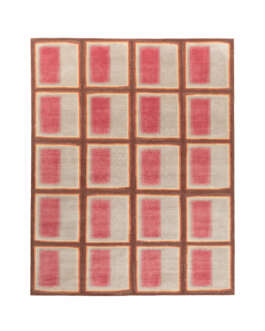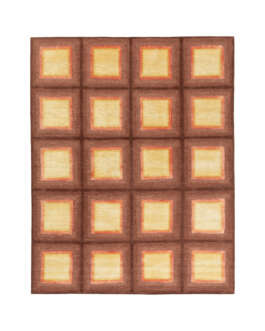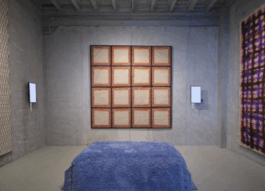



©cc tapis
COLLECTIBLE In-Depth
cc-tapis
August 2025
This series, COLLECTIBLE In-Depth, unveils the backstage of contemporary creation. Tackling various topics from personal designer processes to the position of collectible design on the global design market, COLLECTIBLE In-Depth offers different views to suit all tastes. Today we speak with cc-tapis.
COLLECTIBLE: How did you get into collectible design? Why did you focus your practice on this type of design rather than industrial design?
Kwangho Lee’s : Everything feels like a coincidence, or maybe it was just natural. I have always loved making things with my hands since I was little. My dream is to be a sculptor or installation artist. My major is metalworking and design. Working with a design gallery has led me to create furniture. At the same time, I work with an art gallery to create sculptures and installations. Collaborating with amazing companies like cc-tapis has also led to the release of my designs. While everything feels unexpected, the experiences I have accumulated over time, along with my tastes, have led me toexplore diverse fields without distinction.
C: How do you navigate the tension between innovation and tradition in your approach to designing collectible objects?
KL: I don't feel much tension. I have a clear direction in life that I like. I have lived in the modern era, and after the Korean War, traditional life disappeared, and everything was created anew. Having lived in a highly developed world without any traditional experiences, I believe I explore my work in my own way and with my own eyes. I would like to add that tradition is beautiful in itself, and I have tremendous respect for those who pass it on. However, I distinguish between tradition and my work. I don't try to follow tradition, but rather enjoy observing it from the sidelines.
C: Can you discuss a recent project where community engagement or participatory design methods influenced your design process?
KL: A month ago, I collaborated with Bottega Veneta. I created some of the structures, and the audience participated in the rest, twisting leather to cover the structures I created. It was fun to see the work unfold in a way I hadn't anticipated, and I didn't realize how enthusiastically the audience would participate. Perhaps, as I mentioned earlier, it was a moment where I felt a strong sense of collaboration at every moment.
C: How do you see the role of interdisciplinary collaboration shaping the future of collectible design?
KL: Our lives are rapidly changing, and I believe that the areas of collection and essential items are also changing accordingly. These days, rather than simply predicting the existence of certain objects, I feel it's more important to envision the future through various collaborations and to consider how to create my own objects, my own time, and my own space to fit that future. Where do I exist? How close is the space around me to me? Rather, I believe that even this very moment, the moment we live, is a collaborative effort. Collaboration with people around me, collaboration with family, collaboration with space—what completes my existence lies within me. Seeing the many collaborations around me, I realize that it is I who complete my existence.
C: What have you been up to recently? What are the next projects/exhibitions you wish to highlight?
KL: I'm consistently working on my own projects while also collaborating with various brands. Next year marks my 20th anniversary. I have a solo exhibition coming up in Korea, and I'm also working as creative director for a domestic furniture brand called Wekino, which plans to launch new furniture at the Milan Salone next year.


©Luca Caizzi

©cc tapis
COLLECTIBLE In-Depth
cc-tapis
August 2025
This series, COLLECTIBLE In-Depth, unveils the backstage of contemporary creation. Tackling various topics from personal designer processes to the position of collectible design on the global design market, COLLECTIBLE In-Depth offers different views to suit all tastes. Today we speak with cc-tapis.
COLLECTIBLE: How did you get into collectible design? Why did you focus your practice on this type of design rather than industrial design?
Kwangho Lee’s : Everything feels like a coincidence, or maybe it was just natural. I have always loved making things with my hands since I was little. My dream is to be a sculptor or installation artist. My major is metalworking and design. Working with a design gallery has led me to create furniture. At the same time, I work with an art gallery to create sculptures and installations. Collaborating with amazing companies like cc-tapis has also led to the release of my designs. While everything feels unexpected, the experiences I have accumulated over time, along with my tastes, have led me toexplore diverse fields without distinction.
C: How do you navigate the tension between innovation and tradition in your approach to designing collectible objects?
KL: I don't feel much tension. I have a clear direction in life that I like. I have lived in the modern era, and after the Korean War, traditional life disappeared, and everything was created anew. Having lived in a highly developed world without any traditional experiences, I believe I explore my work in my own way and with my own eyes. I would like to add that tradition is beautiful in itself, and I have tremendous respect for those who pass it on. However, I distinguish between tradition and my work. I don't try to follow tradition, but rather enjoy observing it from the sidelines.
C: Can you discuss a recent project where community engagement or participatory design methods influenced your design process?
KL: A month ago, I collaborated with Bottega Veneta. I created some of the structures, and the audience participated in the rest, twisting leather to cover the structures I created. It was fun to see the work unfold in a way I hadn't anticipated, and I didn't realize how enthusiastically the audience would participate. Perhaps, as I mentioned earlier, it was a moment where I felt a strong sense of collaboration at every moment.
C: How do you see the role of interdisciplinary collaboration shaping the future of collectible design?
KL: Our lives are rapidly changing, and I believe that the areas of collection and essential items are also changing accordingly. These days, rather than simply predicting the existence of certain objects, I feel it's more important to envision the future through various collaborations and to consider how to create my own objects, my own time, and my own space to fit that future. Where do I exist? How close is the space around me to me? Rather, I believe that even this very moment, the moment we live, is a collaborative effort. Collaboration with people around me, collaboration with family, collaboration with space—what completes my existence lies within me. Seeing the many collaborations around me, I realize that it is I who complete my existence.
C: What have you been up to recently? What are the next projects/exhibitions you wish to highlight?
KL: I'm consistently working on my own projects while also collaborating with various brands. Next year marks my 20th anniversary. I have a solo exhibition coming up in Korea, and I'm also working as creative director for a domestic furniture brand called Wekino, which plans to launch new furniture at the Milan Salone next year.

© Nagot

©Luca Caizzi
Contact
info@collectible.design
VIP PORTAL
EXHIBITOR PORTAL
PRIVACY POLICY
© 2025 Collectible
Contact
info@collectible.design
VIP PORTAL
EXHIBITOR PORTAL
PRIVACY POLICY
© 2025 Collectible